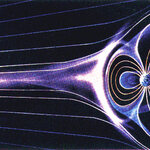Space

Is 'dark energy', the mysterious unidentified thing that would be a nice explanation for a lot of universal questions, physics or religion? Maybe baryon oscillations can tell us.
Baryon oscillations began when pressure waves travelled through the early universe. An ambitious attempt to trace the history of the universe, called the Baryon Oscillation Spectroscopic Survey (BOSS), has seen first light. BOSS, a part of the Sloan Digital Sky Survey III (SDSS-III), took its first astronomical data on the night of September 14th.
That night, astronomers used the Sloan…

There's drama in two galaxies in the Virgo Cluster, NGC 4522 and NGC 4402. An extremely hot X-ray emitting gas known as the intra-cluster medium lurks between galaxies within clusters and, as galaxies move through this intra-cluster medium, strong winds rip through galaxies distorting their shape and even halting star formation - a process known as "ram pressure stripping".
Result: Peculiar looking galaxies.
Ram pressure is the drag force that results when something moves through a fluid — much like the wind you feel in your face when bicycling, even on a still day — and occurs…
Here's an experiment. Prepare for 3 days of hiking. Pack light-- sleeping bag, tarp, knife, matches. Bring protein bars and rice for food. And then pick up 3 gallons (11 liters) of water and start walking. What's the heaviest part of your gear? Of course it's the water.
If we're going to get anywhere in this solar system, we need to go where there is water. Everything else can be dehydrated, miniaturized, made more portable. You can even make oxygen from water, just by adding some electricity (such as from solar power). But water-- which…

Take a decently sized housecat. Let's say a cat that is well-fed and weights 7.5 kilograms. We can all comprehend such a mass. It's not too small, neither too big. A cat is something we can pick up and lift in earth's gravitational field.
A cascade of powers of six-and-a-half billionLet's give each person in the world a cat. You need a massive number of cats with a huge total weight. The total mass of cats needed equates to the mass of the largest concrete structure ever build: the Three Gorges Dam. This dam is big, but not just big. It's awesome. Imagine pouring a tonne of concrete every…

New research says that sunspots provide an incomplete measure of changes in the sun's impact on Earth over the course of the 11-year solar cycle - good news for global warming proponents concerned that lower temperatures (and higher ones) may correspond to solar activity.
The study led by scientists at the National Center for Atmospheric Research (NCAR) and the University of Michigan found that Earth was bombarded last year with high levels of solar energy at a time when the sun was in an unusually quiet phase and sunspots had virtually disappeared.
Scientists for centuries have used sunspots…

I'm torn. There's two ways I would make a new smash video game, "Astronomy Hero".
In the first, you are doing night observing runs, trying to accumulate enough light from each target while evading clouds. Different targets appear at different times of night, and you have to balance whether to finish a given target (accumulate enough photons) or switch to something that just appeared in hopes that you can do better there. Targets of different brightness or dimness require different 'stare' times that you're focusing on them, so you're constantly trying to maximize total on-…

Stéphane Guisard, world-renowned astrophotographer and ESO engineer, has created a 340-million-pixel, 34 by 20-degree wide image from Paranal, the site of the Very Large Telescope, as it looks through an amateur telescope.
Guisard is head of the optical engineering team at Paranal.
To create this true-color mosaic of the Galactic Centre region, Guisard assembled about 1200 individual images, totalling more than 200 hours of exposure time, collected over 29 nights, during Guisard's free time, while working during the day at Paranal.
The image shows the region spanning the sky from…
In a little more than two weeks, NASA will have an expensive hunk of metal slam into the Moon... the resulting plume will be closely observed in hopes to learn more about the possibility of the existence of water ice (read more and learn about how you can participate). As the LCROSS vessel makes it way toward its impact site, NASA needs assistance with tracking due to its steep orbit; they only have brief and infrequent time frames to monitor the trajectory using their Deep Space Network of radio antennas.
So, who better to ask for more listening help than school kids from around the globe…
"It looks, just looks fantastic," said Nicole Stott of the "very shiny ball HTV" in the "beautiful view." The United States astronaut was looking through the windows as she spoke to Houston before she and other flight engineers, Canadian Robert Thirsk and Belgian Frank De Winne, used the station’s robotic arm to grab the spacecraft and attach it to the Earth-facing port of the Harmony node.
The H-II Transfer Vehicle (HTV), launched by the H-IIB Test Flight Launch Vehicle on September 10, 2009 from the Tanegashima Space Center, was successfully berthed at the…
Planck, a European-US collaborative mission launched by ESA, has provided its first pictures. Planck is a followup to WMAP, and looks at the cosmic microwave background. But it has a host of other detectors and purposes, too. Stealing blatently from Wikipedia, Planck will do:
High resolution detections of both the total intensity and polarization of the primordial CMB anisotropies
Creation of a catalogue of galaxy clusters through the Sunyaev-Zel'dovich effect
Observations of the gravitational lensing of the CMB, as well as the integrated Sachs-Wolfe effect
Observations of bright…